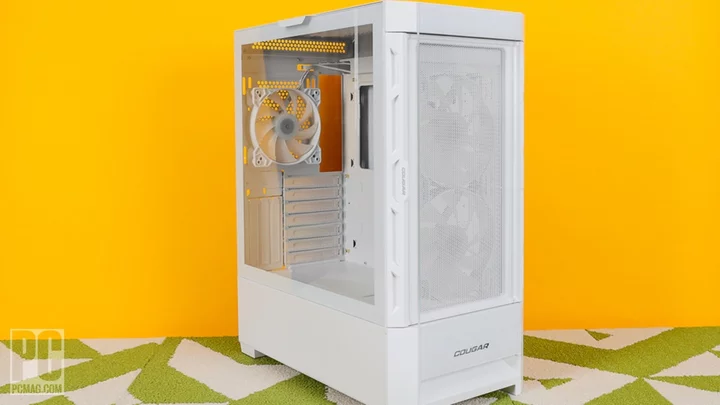Being two-faced doesn’t have a positive connotation, but let’s set that aside for the duration of this PC case review. The “Duoface” in the name of Cougar’s latest value-priced gaming case ($89.99) refers to its two face plates, one being a factory-installed glass face, the other a separately wrapped steel “Airflow” part carried over from the company’s $10-cheaper Airface RGB model. Available in black and white variants, the Duoface RGB is an ATX-and-bigger bargain of a PC case packing a feature list that might make you do...wait for it!...an about-face.
The Design: Bigger on the Inside
Given the Duoface RGB’s total front-to-back depth of only 15.9 inches (which includes 5/8 inch of protruding brackets on its back panel), you may be surprised to learn that this chassis supports motherboards up to the full 13-inch depth of the Extended ATX (EATX) spec.
The extra motherboard space is the first of several deviations our measurements took from Cougar’s specification sheet. On it, the firm lists as supporting motherboards up to 277mm “wide.” Regardless of how large it really is on the inside, the reduced depth on the outside will help the Duoface RGB fit into some tight spaces that traditional EATX cases wouldn’t dream of squeezing into.
Increased motherboard space wasn’t the only deviation from Cougar’s specs; we measured precisely 329mm of the specified 330mm card length limit between the seven-slot expansion panel and the front fan. That may not seem a big deal, but in case it’s a near thing for the card you might use, there’s an explanation for this: Those who choose to deploy the case’s vertical card mount will find that it’s on the outside of the back panel, giving them about an extra 1mm of space before hitting the fan. The blue circle below surrounds what appears to be one (of the case’s two) optional mounting holes for securing a PCIe extension cable’s slot bracket, while the red circle surrounds one (of the case’s three) holes required for the front row of 330mm-deep motherboards.
The Duoface’s namesake feature, its tempered-glass face plate, snaps off and can be replaced by the ventilated steel Airflow alternative face mentioned up top. Behind it, a slide-out dust filter serves both a practical and an aesthetic function when paired with the default glass face plate.
One way that Cougar reduced cost on the Duoface RGB was by eliminating any USB 3.2 Gen 2 headers for a Type-C front-panel port. You get an old-fashioned USB 2.0 port instead, along with two USB 3.2 Gen 1 Type-A ports. Also on the panel are a headset combo jack, a power button, a reset button that’s been repurposed as an ARGB mode selector, and power and hard drive activity LEDs behind two pinholes.
Pulling off the magnetically attached filter sheet and pulling back our camera, we see two sets of top-panel fan mounts spaced to hold a pair of 120mm fans, or a pair of 140mm fans inside the case (or one of each size, if that floats your boat).
The bottom panel also has a filter sheet, but it’s only large enough to cover the power-supply air inlet, and it’s secured via tabs at the edges. This kind of filter design always proves a nuisance to remove to service (well, unless yours happens to simply fall off, as ours did in shipping).
When we said that a 13-inch-deep (330mm) motherboard would fit, we avoided the topic of sticking 1mm of its front edge behind the rear face of the Duoface’s intake fans. Those who need more clearance around that front millimeter could potentially replace the stock 140mm front fans with 120mm or even slim-chassis 120mm parts, and the original 140mm fans can even move up to the top panel if keeping these is a sticking point.
The front of the power supply tunnel has a 2.5-inch gap that would allow oversized radiators to hang below the bottom fan, which might be a necessity for the end caps of certain 280mm-format units. All but the front 1.1 inches is filled with a lower drive cage by default.
Flipping the case around, we can see that the drive cage in question has a second mounting position that’s closer to the power supply (by 1.4 inches, according to our measurement). Placing it there would reduce the supported maximum power supply depth from a measured 220mm to a measured 185mm, but both of these measurements far exceed Cougar’s stated 160mm PSU depth limit.
The drive cage holds up to two 3.5-inch drives: Two separate 2.5-inch drive trays live above it, on the back of the motherboard tray.
The included ARGB controller is located bit farther up the back of the motherboard tray and serves up to six devices, three of which are the two front fans and the front logo’s mini light bar. The case’s original reset button has been repurposed as an ARGB mode selector pointing out the top, while an ARGB input cable pointing out the bottom allows the unit to act passively as a powered ARGB hub. The power cable also points out the bottom, while the rear fan connects to one of the three remaining ARGB ports on the right of this photo.
Building With the Duoface RGB
The Airface alternative face plate is packaged separately, beside the case, in the case’s larger shipping box.
Speaking of tucking a box inside a box, the hardware kit is located within a 3.5-inch drive form-factor cardboard box, stuffed inside the lower drive cage in the power supply tunnel of the case. Included are a manual, a three-fan splitter cable, a bag of mounting hardware with enough standoffs to support a full-spec EATX motherboard, and six cable ties.
The case cables include an ARGB signal input and a SATA power input for the ARGB controller, a front-panel button and indicator LED group that’s missing its RGB lead (see the ARGB controller for its location), three 3-pin fan headers, HD Audio (for the headset combo jack), a USB 2.0 header plug that’s filled on only one row, and a USB 3.2 Gen 1 cable for the other two Type-A ports.
Our test hardware includes a Corsair iCue H100i RGB Pro XT CPU cooler and FSP’s Dagger Pro 850W power supply, both of which were supplied specifically for these reviews and have served us flawlessly through dozens of builds.
Test Hardware
The Duoface RGB has more than enough space for our full ATX components, and we can even see the three standoff holes for 13-inch-deep motherboards located just behind the front fans in this photo. Notice that the top panel’s 2.4 inches of space above the motherboard leaves over 0.3 inch of space between our cooler’s fans and its top edge.
And now we’re back to where we began, with a side-by-side comparison of the Duoface’s two face plates.
The glass panel that’s factory installed on the Duoface features giant gaps at the side, so we thought it would also feature giant airflow. But swapping that one part out for its ventilated steel Airflow counterpart moved this case from last place to first place in CPU cooling performance. The actual temperature difference of 7 degrees is something we would have doubted, had we not seen it ourselves. (As you can see, we tested the Duoface case with each face, in turn.)
The same difference that we saw in our CPU temperature also appeared at our motherboard voltage regulator, which gets most of its cooling from our CPU cooler’s fans. We might have suspected a test discrepancy except for the fact that we didn’t even shut the machine down between the glass- and steel-face tests: We had simply stopped the test, swapped the face panels, allowed the system to cool for a while, and restarted the test.
Just in case anyone was starting to think that something affecting our CPU fans was responsible for the above cooling differences between the two Duoface panels, a 3-degree difference in GPU temperature also indicates that the steel Airflow face dramatically increases air inflow.
A faceplate that raises the case’s internal temperature by 3 degrees at least ought to be able to decrease its SPL by 3dBA, no? But alas, the glass face made the Duoface RGB only a single decibel quieter than the Airflow face.
Verdict: With the Duoface, the Airflow Is the Way to Go
Considering all of its features and performance, the $90 Duoface RGB appears to be an exceptional value…coming up just a Gen 2 Type-C port short of being a practically perfect value. Alternatively, Cougar also offers the $80 Airface model, which includes only the better-performing Airflow face, but also differs in that its front-panel filter is nylon instead of steel.
Having not tested this case with the nylon filter, we can’t say for certain that it would perform identically to the Duoface case’s best-performing configuration. Anything’s possible; that mesh could let through more or less air, and affect our test results. But we think the $10 difference is well worth spending both for the alternate glass face option—even if it may leave your case a bit toastier inside—and for adhering to the old maxim of not messing too much with a good thing. "Face" it: Having a choice is good.









